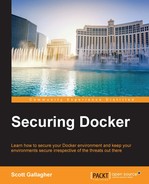In this chapter, we looked at how to secure our Docker hosts. The Docker hosts are the first line of defense as they are the starting point where your containers will be running and communicating with each other and end users. If these aren't secure, then there is no purpose of moving forward with anything else. You learned how to set up the Docker daemon to run securely running TLS by generating the appropriate certificates for both the host and the clients. We also looked at the virtualization and isolation benefits of using Docker containers, but make sure to remember the attack surface of the Docker daemon too.
Other items included how to use Docker Machine to easily create Docker hosts on secure operating systems with secure communication and ensure that they are being set up using secure methods when you use it to set up your containers. Using items such as SELinux and AppArmor also help to improve your security footprint as well. Lastly, we covered some Docker host operating systems that you can use for auto-patching as well, such as CoreOS and Amazon Linux AMI.
In the next chapter, we will be looking at securing the components of Docker. We will focus on securing the components of Docker such as the registry you can use, containers that run on your hosts, and how to sign your images.
